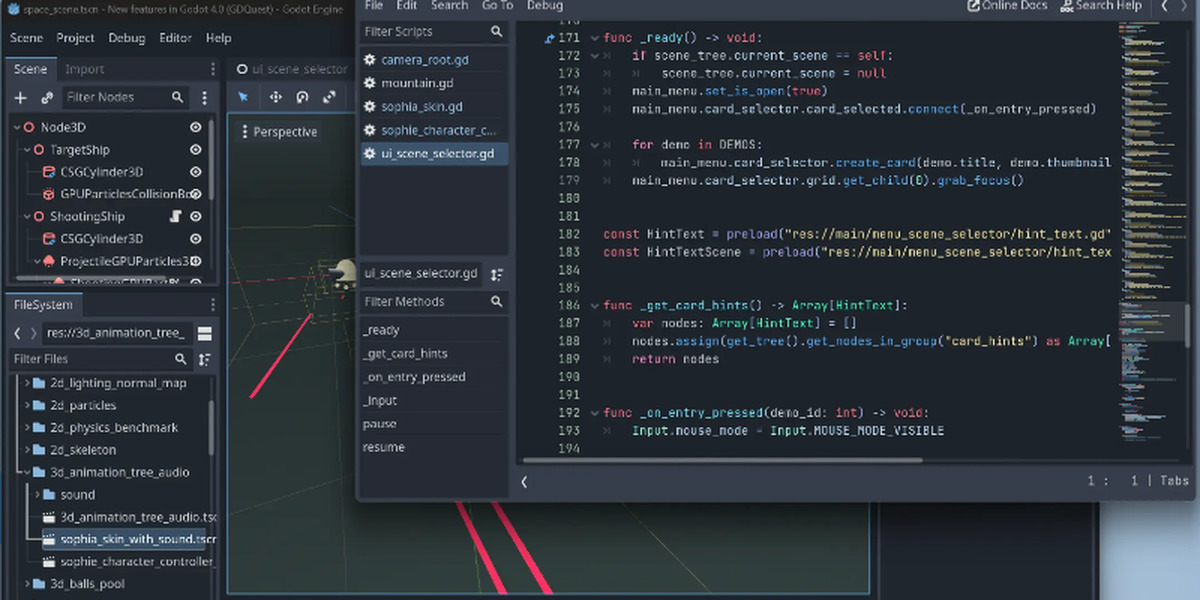Dev snapshot: Godot 4.2 dev 6
This is the final dev snapshot for 4.2, signaling the end of the feature development cycle, and the start of the beta phase. We spent the past couple of weeks wrapping up many of the big feature PRs which had been in development for the past few weeks and months. We still have a handful that the production team is keeping tabs on, but we’ll soon declare the full feature freeze for 4.2 and get ready for the first beta snapshot. But don’t wait for the beta to try what’s new in 4.2 – there are tons of amazing new features in this dev snapshot which require testing and user feedback, so we can iron out the main issues before the stable release.
Here’s a selection of some of the biggest changes since our previous 4.2 dev 5 build, ahead of a more complete list below:
The rendering contributors have outdone themselves this cycle, and a lot of their work has been merged for this snapshot:
AMD’s FSR 2.2 has been implemented as a new upscaling option in the project settings. Have fun testing it and let us know how it goes :)
An optional ANGLE-backed OpenGL renderer was added for macOS and Windows ( GH-72831). ANGLE is a compatibility layer for OpenGL on top of Metal and Direct3D 11, which allows us to work around the deprecated and unmaintained OpenGL drivers on macOS, and similarly outdated OpenGL drivers on Windows for some older integrated chipsets. This should increase the portability of Godot games on lower end devices.
Talking about the OpenGL Compatibility renderer, one of its main missing features, 3D shadows, has now been implemented ( GH-77496)!
For lightmapping, we replaced the extremely bulky and slow OIDN denoiser with a lightweight and much faster JNLM denoiser compute shader ( GH-81659). There is a noticeable decrease in denoising quality with the much simpler JNLM approach, but we expect that the results might be satisfactory for most games. Please try it out and let us know if you’re happy with the results. If there’s demand for it, we might re-introduce OIDN as an option, using it as a standalone command line tool instead of building it together with Godot. With the built-in OIDN removed, editor binaries are now approximately 4-5 MB smaller.
A lot more bug fixes to lightmapping quality and consistency, such as GH-61910, GH-81545, GH-81872, GH-81951, and GH-82533.
We also forward-ported the OpenXR foveated rendering support from Godot 3.x ( GH-80881).
Glow behavior has been optimized to be closer to the high quality mode we had in Godot 3.x ( GH-82353).
On the animation front,
AnimationPlayerandAnimationTreeAPIs have been partially unified via a commonAnimationMixerbase class, solving a number of issues in the process ( GH-80813).The C# integration received a number of improvements, both in the bindings ( GH-81101, GH-81783), language interoperability ( GH-67304), backward compatibility ( GH-80527), and editor UX ( GH-80260).
The GDExtension team has been wrapping up their feature work, notably with the long awaited support for hot reloading extensions in the editor ( GH-80284), as well as an option to include the class reference in the extension API JSON ( GH-82331).
- After some fixes in previous snapshots, the Web platform should now support loading dynamic libraries, i.e. GDExtension support! The latest fix was just merged ( GH-82633) and still needs user testing, so please let us know if you can compile a GDExtension for the Web and load it successfully in your Godot project.
GDScript also got a number of new features, such as raw string literals ( GH-74995), pattern guards for
matchstatements ( GH-80085), and a new--lsp-portcommand line argument that will be useful for authors of LSP plugins to support both Godot 3.x and 4.x, as well as multiple editor instances.Lots of improvements in the editor, such as an overhaul of the Gradient editor ( GH-71915), the ability to select where to install the assets that you’re downloading from the Asset Library ( GH-81620), and various fixes to the script editor and FileSystem docks, among others.
After a massive performance improvement to TileMap quadrants in the previous snapshot ( GH-81070), the Y-sort performance now got a significant increase ( GH-73813).
2D navigation mesh baking was added ( GH-80796), including support for TileMaps ( GH-82465).
Visual shaders got some nice improvements with the addition of drop-down list properties to custom nodes ( GH-81688), and output ports for vector types are now expandable by default ( GH-82088).
Keep in mind that while we try to make sure each dev snapshot is stable enough for general testing, this is by definition a pre-release piece of software. Be sure to make frequent backups, or use a version control system such as Git, to preserve your projects in a case of corruption or data loss.
Jump to the Downloads section, and give it a spin right now, or continue reading to learn more about improvements in this release. You can also try the Web editor or the Android editor for this release. If you are interested in the latter, please request to join our testing group to get access to pre-release builds.
The sixth development snapshot of Godot 4.2 has been released. The Godot Engine is a free, cross-platform game engine that allows you to easily create 2D and 3D games.

